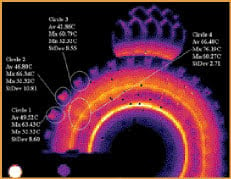Brent D. Johnson, Senior News Editor
Tire failure can be sudden and catastrophic. Perhaps no one knows this better than the families of 88 people whose deaths were linked to defective Firestone ATX and ATX II tires installed on Ford Explorers. While these two companies battle over issues of culpability, it is significant to note that a technology under development might prevent future incidents.

Using an IR imaging system to predict tire failure could be a lifesaver.
Ray Schandelmeier, program manager for Radian Inc., has been working with the National Automotive Center and the US Department of Defense to develop the Thermal Imaging Inspection Station. By imaging an infrared oblique view of the tire, it is possible to correlate internal defects with tire failure.
He is correlating his lab research with fieldwork in which he is using the system to test 14.00R20s tires, which the Army uses on its 5-ton trucks. When mounted for testing on a dynamometer, a tire and test fixture weigh 400 to 500 lb. A ram pushes the tire against a 67-in. drum, which turns at effective speeds up to 120 mph. The dynamometer includes an internal inflation system that enables tire pressure adjustments during testing.
By looking at images that show thermal signatures, Schandelmeier can determine whether a tire is about to delaminate. "In some cases, it's quite apparent," he said. "You can see there's a flaw."
He said the departments of Defense and Transportation like to see data rather than pictures, so he has been trying to capture thermal data. However, he discovered a flaw in the original software that created problems in the data translation of the images.
Ben Lamfers at Edward Integrated CAD told him that he had software that could work in his application. Schandelmeier responded: "If it works, you'll walk out of here with a purchase order."
After a demonstration Schandelmeier said that, with a little tweaking, the software would be just what he needed. "Lamfers had it ready to go within 45 days," he said. And he provided "just amazing support."
The current incarnation of their software, ThermoSoft II, images IR wavelengths at 60 frames per second, providing real-time capability.
One of the key benefits of the software is that it is calibrated directly from the camera. "That's indispensable," he said. "It becomes very clunky if you don't."
Radian plans to incorporate this technology into a portable system for use at truck stops and weigh stations to test for tire degradation. Schandelmeier believes he is about two years away from a commercially viable handheld device.